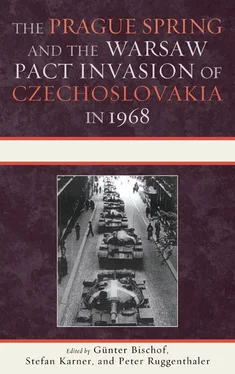“A SERIOUS SETBACK FOR DÉTENTE”: WHAT ELSE?
On the morning of 22 August, Minister for Foreign Affairs Waldheim gave the Austrian Press Agency an assessment of events in Czechoslovakia. He referred to what the federal chancellor had already said on the subject and explained:
The Austrian people have reacted to events in Czechoslovakia with dismay. Developments over the past few weeks have been followed with a great deal of concern, and we had hoped it would be possible to settle differences at the negotiation table. We deeply regret that this has come to naught—and we regret this all the more since the Austrian government has always advocated the peaceful development of interstate relations and will continue to do so. The latest events certainly constitute a serious setback 21for the process of détente, which we have always upheld and which has fortunately 22made such progress over the last few years. It is still too early to say how the situation will develop from here. All we can do is to hope that a normalization that takes into account the wishes of the long-suffering population 23will take place in our neighboring country, which we feel connected to by untold ties of friendship and blood.
On the evening of the same day, Federal Chancellor Klaus addressed via TV the Austrian people with remarks made in a similar vein. Klaus assured his audience that the government had taken measures that “reflect our unique vital interests as a permanently neutral state.” In more concrete terms, he mentioned stepping up the protection of the borders and preparations for the reception and accommodation of refugees, the need for which was a distinct possibility. Klaus criticized the invasion of Czechoslovakia indirectly as a “blow to the policy of détente of the last few years, to peaceful coexistence, and to the development of amicable relations between the peoples of Europe.” He wound up by expressing the hope that “all possibilities will be used that may exist even at this late hour in order to bring about a normalization of the situation in Czechoslovakia.” 24
As opposed to Hungary in 1956, the Warsaw Pact troops had received orders this time not to prevent people from leaving Czechoslovakia. On 18 August, Leonid Brezhnev told the Communist leaders of the “fraternal states” not to stop “defectors wishing to depart for the West. We herd these renegades together, and then we don’t know what to do with them. Should we sentence them to imprisonment, hang them, or let them go? After all, no upright guys will want to flee anywhere and if they’re counterrevolutionaries, let them go.” 25
When a large number of Czechs turned up at the Austrian embassy on the morning after the invasion to apply for visas, the Ministry for Foreign Affairs in Vienna was contacted for guidelines. A day later, on 22 August, a directive arrived from the Ministry of the Interior: “The embassy building is to be locked… and access to be granted only to Austrian passport holders. Czechoslovak citizens who are inside the building at this stage are to be informed that the embassy is reserved for the exclusive use by Austrians,and they are to be persuaded to leave the building of their own accord.” 26When Austrian Ambassador Rudolf Kirchschläger returned to Prague on 22 August, he decided to ignore this order: “I must confess that I would end up in the most dreadful moral quandary if I were to carry out this directive.” When a cache of 10,000 blank ČSSR passports was found, another security directive arrived from Vienna on 25 August that remained similarly unheeded: no more visas for Czech passport holders. Kirchschläger cabled to Vienna on 30 August: “There is widespread apprehension and despair here, which is reflected in the rising number of applications for visas: 2,006 have been issued today and the number is still rising.” The number of refugees was to rise to 208,000 by the end of 1968.
After 30 August, the number of refugees was augmented by the 50,000 or so Slovak and Czech holidaymakers who had been vacationing on the shores of the Adriatic or the Black Sea and were caught unawares by the invasion. The wife of Czech leader Alexander Dubček, who was one of them, was offered protection by President Josip Broz Tito of Yugoslavia, which she declined. 27
Vienna and Lower Austria bore the brunt of coping with the influx of refugees with help from the United Nations (UN). According to the UN High Commissioner for Refugees, approximately 70,000 Czechoslovak citizens were in Austria between 26 August and 6 September, most of whom were refugees. 28Of these, 53,314 were put up in temporary housing, 1,650 in private homes, 5,074 in hotels in Vienna, and another 10,737 outside of Vienna, mostly in Lower Austria. The majority of refugees were young, talented, and well educated. Quite a few decided in the end to remain in Austria, including people of the caliber of Karel Krautgartner, Zdeněk Mlynář, and Pavel Kohout.
VIOLATIONS OF AIRSPACE AND NO END IN SIGHT
No end was yet in sight for the violations of Austria’s borders. In the first days after the invasion of Czechoslovakia, several incidents took place. On 23 August, a Soviet helicopter gunship landed near Unterretzbach, and two Soviet jets penetrated approximately ten kilometers into Austrian airspace near Altnagelberg. Yet these and other comparable incidents still failed to draw protests from the Austrian government. In the manner that had already become almost a routine, the Soviet ambassador was, in his own words, “invited” to the Austrian Foreign Ministry. 29That day, at 10:45 a.m., the Foreign Ministry general secretary, Wilfried Platzer, acting at Waldheim’s behest, handed the Soviet diplomat a list of the border incidents. He explicitly stated that “this was not to be interpreted as a note”; the Austrian purpose was to inform the Soviets as to the precise timing and location of the incidents. 30Podtserob once again expressed “regret at the violations of Austria’s borders,” adding “that these were not intentional.” He renewed his assurance to “inform Moscow so that adequate measures would be taken.” 31In the further course of the meeting, the Soviet diplomat also mentioned the Austrian chancellor’s televised address of the previous night. He asked Platzer whether it was the chancellor’s intention “to call Austria’s policy of neutrality into doubt.” 32In his reply, Platzer averred that “reducing tensions and enhancing security and cooperation in Europe were longstanding political objectives of the Austrian government” and “that Austria is committed to a policy of neutrality and determined not to be deflected from this course.” Platzer also assured Podtserob that he was going to discuss this issue with Chancellor Klaus. At the end of the conversation, Platzer thanked Podtserob for the fact that Austrians were free to leave Czechoslovakia without permission or hindrance and that Austria’s ambassador to the Czechoslovak Socialist Republic (ČSSR), Rudolf Kirchschläger, had likewise been enabled to return safely to Prague by car. 33
After this meeting between Ambassador Podtserob and General Secretary Platzer, a certain amount of hectic activism seems to have taken hold of the Ballhausplatz. Foreign Minister Waldheim repeatedly tried in vain to reach the Soviet ambassador on the phone. His failure was due to the fact that the diplomat had left the meeting at the Foreign Ministry to attend a function at the Romanian embassy on the occasion of Romania’s National Day. On his return to the Soviet embassy, Podtserob was informed of Waldheim’s urgent wish to speak to him. In the phone call that followed, Waldheim once more underscored the statements made by Chancellor Klaus in his televised address and Platzer’s assurances as to Austria’s commitment to neutrality. Waldheim added that Austria was going to “adhere to its course of neutrality and would not consider other options under any circumstances.” The Austrian Foreign Minister made it explicitly clear that his statement was official in character. 34
Читать дальше












